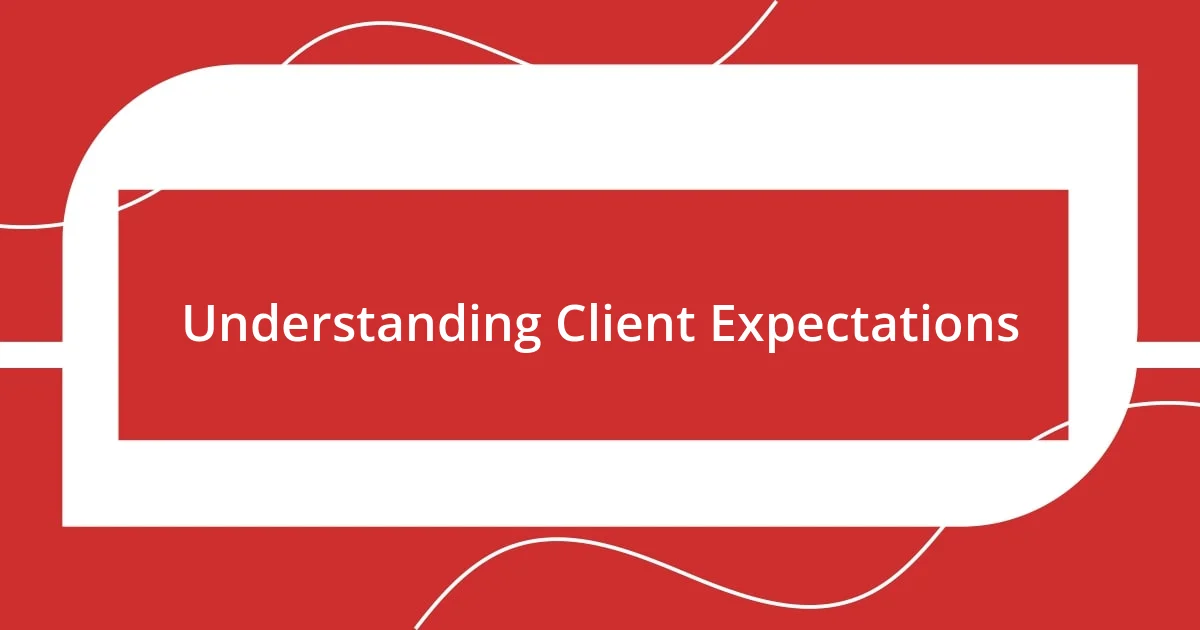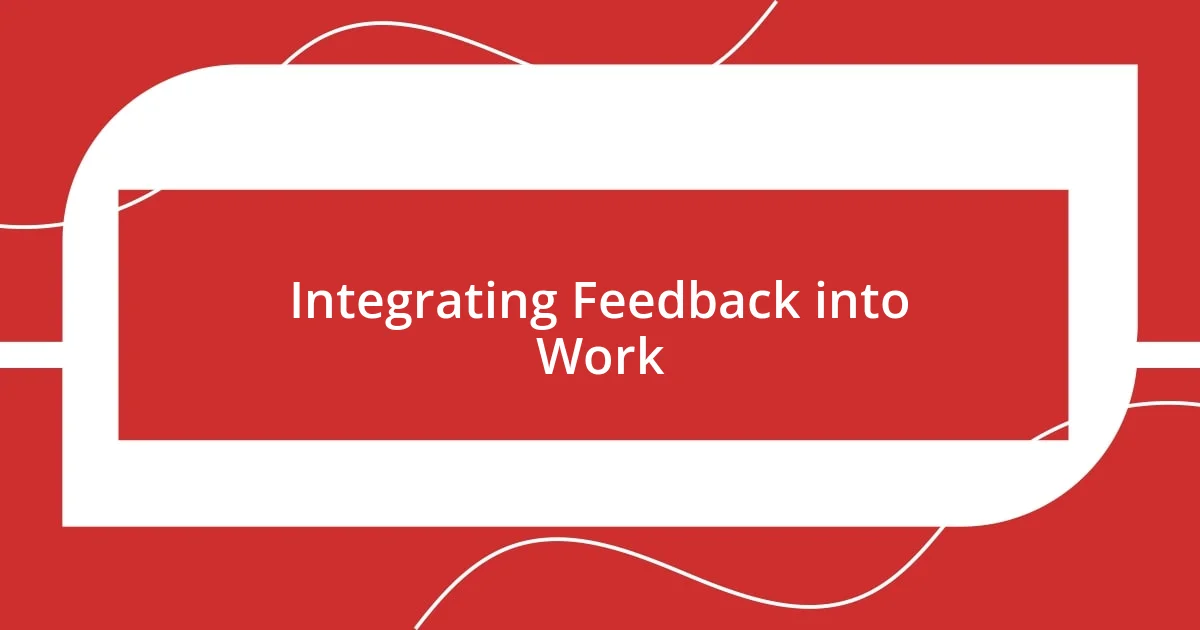Key takeaways:
- Engaging in open communication and summarizing client expectations fosters trust and alignment in projects.
- Establishing clear creative boundaries enhances collaboration and allows for a structured exploration of ideas.
- Integrating client feedback and celebrating creative successes revitalizes the creative process and strengthens team morale.

Understanding Client Expectations
To truly understand client expectations, I find it vital to engage in open conversations from the outset. I recall a project where the client seemed hesitant to articulate their needs clearly, which led to misunderstandings later. Have you ever faced a situation where assumptions led to more questions than answers? Establishing a comfortable communication channel can often open the door to a clearer vision of their desires.
I also believe that paying attention to non-verbal cues can be just as revealing as listening to what is said. In one instance, during a brainstorming session, I noticed my client’s enthusiasm waning whenever we discussed a particular concept. It made me wonder — what other hidden feelings were at play? This taught me that understanding expectations is a multi-faceted process, where both words and gestures matter.
Moreover, summarizing what I’ve understood and asking for their feedback has become a crucial step in my process. When I wrap up a meeting by paraphrasing their key points, it not only reassures them that I’m on the right track, but it also provides an opportunity for correction. Have you tried this approach? I’ve found that this simple technique fosters trust and ensures that the relationship is built on alignment rather than assumptions.

Identifying Creative Boundaries
Identifying creative boundaries is a skill I’ve honed over time. Initially, I often blurred the lines between what the client wanted and my own creative preferences. For instance, there was a project where I was convinced that a vibrant color palette would dazzle the audience. However, after discussing it with the client, I learned they preferred a more muted aesthetic. This experience taught me that defining these boundaries early on can prevent unnecessary friction and ensure we’re both on the same page.
As I navigated through various projects, I found that setting clear creative boundaries allowed for a more structured exploration of ideas. One memorable meeting comes to mind when my client expressed a desire for an innovative direction but lacked specific parameters. I proposed a framework for our brainstorming sessions, encouraging them to articulate what felt too far from their vision. This collaboration not only enhanced the creative process but also solidified mutual respect for each other’s expertise. Have you had moments like this where clarity transformed your working dynamic?
Recognizing the significance of creative boundaries has been a revelation in my work. I realized that while flexibility is essential, it’s equally important to anchor our efforts within a defined scope. I often create a simple “yes/no/maybe” list based on client feedback, which helps us visualize our shared vision. This approach has empowered my clients to feel more engaged while liberating my creativity. How do you establish yours? I’ve learned that it’s a balancing act, but taking the time to identify those boundaries helps us thrive together.
| Creative Boundaries | Client Needs |
|---|---|
| Establishing a defined scope | Articulating preferences clearly |
| Encouraging open dialogue | Providing structured feedback |

Establishing a Feedback Loop
Establishing a feedback loop is something I consider vital in any creative collaboration. I’ve experienced firsthand how a continuous exchange of ideas can transform a project. I recall a time when I was working on a brand logo, and instead of waiting for the final reveal, I shared my initial sketches with the client. Their immediate reactions sparked a dynamic conversation that ultimately led to a design that truly resonated with their brand. It was an eye-opener for me—having their insights early in the process was invaluable.
To create an effective feedback loop, implementing structured methods can be incredibly beneficial. Here are some strategies that have worked well for me:
- Regular Check-ins: Schedule consistent meetings to gather thoughts on the progress.
- Visual Updates: Share drafts or visual progress regularly, inviting input.
- Feedback Forms: Utilize simple forms or surveys to standardize client feedback.
- Open Channels: Ensure they feel comfortable communicating any immediate thoughts.
- Iterative Approach: Embrace an evolving design process, building on client input at each stage.
By incorporating these strategies, I’ve found that not only does the work improve, but the relationship with the client also strengthens. It evolves from a transactional dynamic to a collaborative bond, where their voice is valued throughout the journey.

Balancing Creative Risks
Balancing creative risks is a thrilling yet daunting part of my work. There have been times when I took a leap of faith on a project that pushed boundaries—like when I decided to incorporate an unconventional graphic element in a client’s advertising campaign. Initially, I could sense their hesitation. But after diving into the rationale behind my choice and illustrating its potential impact, they were on board, and the result was a campaign that caught attention for all the right reasons. Isn’t that exhilarating?
In my experience, the key to mitigating risks lies in understanding the client’s comfort zone while also challenging it. One project stands out where I suggested a bold approach for a social media initiative; it sparked a lively debate with the client. By presenting data on current trends alongside my vision, I demonstrated calculated risks could yield transformative results. In the end, they appreciated my push for creativity, which led to a record engagement level. How do you strike that balance when you feel passionate about a concept?
I often remind myself that creativity thrives in environments where risk is encouraged but defined. During one brainstorming session, a client nervously dismissed an idea that felt too adventurous. Instead of dismissing their concerns, I took the time to break down the uncertainties and clearly outline what was at stake. That moment clarified for both of us how necessary it is to tread thoughtfully while still exploring the outer limits of creativity. Have you found that risk-taking can sometimes lead to the best breakthroughs? I certainly believe it can, especially when approached collaboratively.

Integrating Feedback into Work
Integrating client feedback into my work is like adding layers to a beautiful painting. I really strive to view feedback not as criticism, but as an opportunity for growth. I remember when I was refining a website design; my client pointed out elements that were off-brand. Initially, it felt disheartening, but once I delved deeper into their vision, the revisions not only elevated the design but also connected more profoundly with their audience. Have you ever felt that shifting perspective transform your work?
One practical approach I’ve embraced is the “Feedback Reflection Session.” After receiving input, I take a moment to reflect and categorize it—what resonates, what requires more explanation, and what might not fit. For instance, during a project for a nonprofit, the feedback was overwhelming at first. By breaking it down, I identified key themes and pinpointed what truly aligned with their mission. This helped streamline our discussions and made the final output that much more impactful. How do you approach feedback when it feels like a flood?
Ultimately, each piece of feedback offers insight into the client’s world, providing a lens through which to see my work afresh. It’s invigorating to realize that their feedback can guide me to more innovative solutions. Just recently, while working on a product launch, a suggestion from the client about tweaking the messaging opened the door to a more authentic narrative that resonated with potential customers. It made me wonder: how often do we overlook the treasure trove of ideas clients can provide? Engaging with their input transforms our collaboration into a dance of creativity, where both sides bring something beautiful to the floor.

Setting Realistic Project Timelines
When it comes to setting realistic project timelines, my experience has taught me the importance of clear communication. I remember a particular project where we aimed for an ambitious launch date. It felt exciting at first, but I quickly realized that enthusiasm could cloud judgment. By opening a dialogue with the client about their expectations and our capabilities, we clarified a timeline that was achievable, preventing unnecessary stress down the line. Have you ever felt pressured by a deadline only to wish you had taken a step back?
I’ve come to appreciate the role of negotiation in this process. One time, a client wanted an all-encompassing strategy completed in a week, which was undeniably optimistic. I shared a breakdown of the critical tasks involved, highlighting the effort required for quality work. Through that conversation, we settled on a timeline that allowed space for revisions, ultimately leading to a more polished final product. Don’t you think collaborating on deadlines can create a sense of shared investment in the project?
The challenge often lies in predicting potential roadblocks. I remember working on a video campaign where unexpected challenges arose during filming. By factoring in “buffer time” in our timeline, we adapted smoothly, ensuring we didn’t compromise the quality of the final piece. I can’t stress enough how essential this proactive approach is; it encourages creativity while respecting the realities of a project. Have you found that forecasting challenges can actually decrease anxiety and enhance focus?

Celebrating Creative Successes
Celebrating creative successes is an essential practice that fuels my passion for my work. Reflecting on a recent advertising campaign, I remember the moment we received an award for creative excellence. It felt incredible not only to be recognized but to see how our dedication resonated with our audience. Have you ever felt that surge of pride when your work is acknowledged in a meaningful way?
One way I commemorate these achievements is by sharing them with my team. During our weekly meetings, I highlight the efforts of individuals whose contributions made a significant impact. Recently, a junior designer’s idea transformed a dull concept into something captivating. I could see their eyes light up as the team celebrated their creativity. Isn’t it rewarding to witness someone’s hard work come to fruition and to know you played a part in their journey?
I also find value in tracking these victories for personal motivation. Keeping a “success journal” has become a practice of mine, where I document not just the accolades but the lessons learned. For instance, after a successful product launch, I took time to note what strategies worked and how they could inform future projects. Have you tried something similar? This practice ensures that I’m not just looking ahead but also cherishing the creative milestones that continually inspire my journey.















